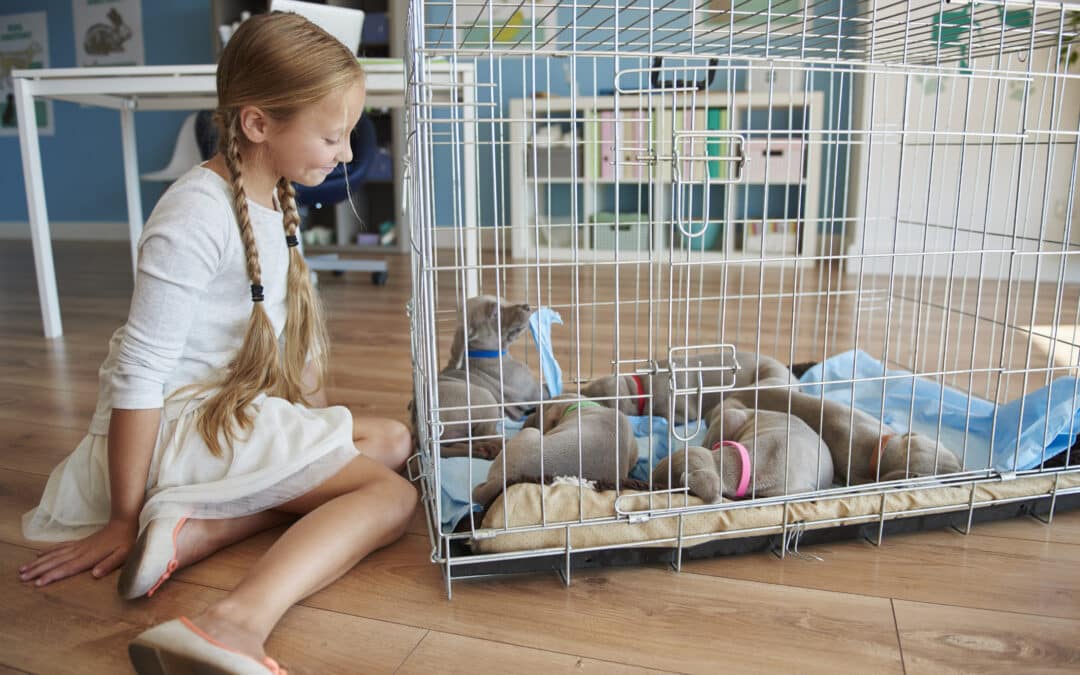Crate Training a Puppy: Step-by-Step Guide for New Owners
Crate training has many benefits: it improves safety, makes traveling easier, speeds up housetraining, imparts damage prevention, and more. Your puppy should be confined to a safe area when they are not with you, and the crate should be large enough for your puppy to stand up and turn around.
If you’re considering crate training your puppy, you might be wondering about the benefits, efficacy, and safety. Your dog needs their own space, and you need to ensure the safety of your puppy, your belongings, and other people and pets. Read on to see why crate training is so important, and why many pets and pet owners benefit from a crate-trained puppy.
Table of Contents
What Are The Benefits of Crate Training a Puppy?
While your dog’s crate might look like a fairly basic enclosure, it can become your pup’s favorite place to be. Crate training can benefit both you and your dog in several ways when used correctly. If you’re curious about pet behavior counseling or other training regimens, contact Paoli Vetcare.
Providing Your Dog with Their Own Space
Space is important to both you and your pup. It’s important to pick a crate of appropriate size, so that your dog can gradually grow into it and become acclimated with the space. Introducing your dog to the crate over a longer period will enable your pet to see this space as a comfy refuge and not a punishment. Dogs prefer enclosed, protected areas when they are bedding down, and a good crate helps that natural inclination. Over time your dog will see their crate as a safe space and utilize it willingly.
Promoting Successful Potty Training
Proper crate training helps streamline the entire house training process. Pups won’t soil where they sleep, and when they are properly crate trained, they are learning key steps in their potty training process. This efficiency allows you to train them in two ways simultaneously!
Ensuring the Safety of Your Puppy (and Your Belongings)
Supervision is the number one component of successful dog training, especially when your furry friend is just a puppy. Most pet parents can’t watch their puppies full-time, even when utilizing camera technology. Crate training can save the day by keeping your curious pup safe. This will ensure that, while you can’t always keep an eye on them, you can rest easy knowing that they aren’t damaging their belongings or harming themselves.
Offering a Safe Haven for Rest and Recovery
Everyone needs a spot for rest and recovery. Crate training a puppy during the day is important, but so is crate training a puppy their first night. You want to make a space for them that feels safe, inviting, and restful.
At various points in your dog’s life, you will have to restrict their movement, whether it’s due to an injury, medical procedure, or travel. Making sure that your dog is happy in their crate is the perfect way to “future-proof” these situations—if your dog is already comfortable in their crate, they won’t become scared or anxious when you need to put them there.
Choosing The Right Crate
There are a few things you can do to make your dog’s crate their happy place. You need to make sure it’s just right for them—and when looking at crates, there are lots of options. Choosing the right crate doesn’t have to be difficult if you consider type and size. Obedience training for puppies happens gradually, but is very beneficial!
Type
Type can fall into two categories: hard plastic or wire. Hard plastic crates are airline-style enclosures, and wire crates come in options such as single-door or collapsible. Typically, puppies can learn to be comfortable in either type, though there’s versatility to consider between the two kinds. Door placement, customization, size of the interior, and other utility and comfort considerations must be made. Don’t force your puppy into a space they don’t like!
Size
Finding the correct size crate is paramount to whether or not your dog sees their crate as a comfort or a punishment. Your dog’s crate should be large enough for your pup to stand up, turn around, and lie down comfortably. While it might be tempting to purchase a “big” crate that allows more room, oversized crates can create kinks in the potty training process by giving your pup the space to go to the bathroom in one corner and sleep in the other.
If your puppy is a large breed, you can anticipate your dog’s adult-grown by purchasing the largest-sized crate and then using an adjustable crate divider to only allow them the space they need. Collapsible crates with dividers are available in many different sizes and types, and you want a crate that grows alongside your puppy.
What Other Supplied Are Needed
- Bedding: To keep your dog safe and comfortable, you’ll need bedding. If you are still house training a puppy you should avoid extra-plushy dog beds and bedding, as the extra cushioning might absorb the urine and make it more difficult to see if they’ve had an accident. Puppies can also be tempted to chew up stuffed bedding when left in their crate. Simple mats and blankets are the best option when your pup is still acclimating to its new crate.
- Treats: Snacks are an important part of any training regimen, as they are an easy way to offer comfort to a puppy who feels anxious or scared. Small savory treats help reinforce the idea that their crate is a good place, especially if you provide them with treats to snack on while they are not with you.
- Toys: It can be a challenge for some dogs to chill out in their crate, especially if they have a lot of energy. It’s important to give your dog something to do, such as providing them with a toy. Chew toys can stand up to your puppy’s powerful teeth, and you should always make sure that whatever toy you provide them with won’t be torn to shreds when you aren’t looking.
Steps for Crate Training Your Puppy

Crate training isn’t an exact science—it can take days or weeks, depending on your dog’s past experiences, age, and temperament. The crate should always be associated with something pleasant, and crate training should happen in a series of small steps. Training your puppy is important; don’t speed things up because of your impatience.
Step 1: Introduce Your Dog to the Crate
Keep the crate in an area of your house where the family spends a lot of time, such as your kitchen, living room, or family room. Make sure the crate has a soft blanket, and take the door off or keep it open. You want your dog to be able to explore the crate at their leisure, and since most dogs are naturally curious they should become interested in the crate on their own.
If your dog isn’t interested in their crate, bring them over to it and speak to them in a happy, pleasing tone. Ensure the crate’s door stays open, and encourage your dog to enter it by keeping treats nearby. If they refuse to enter the crate, don’t force them. This is a training process and it happens gradually.
Toss treats into their crate until they calmly walk in on their own and get the food. If they aren’t interested in the treats you are providing, try using a toy or something else they love. This step could take up to several days to complete.
Step 2: Feed Your Dog Meals in the Crate
After your dog has made a successful introduction and is entering and exiting the crate on their own, you can begin feeding them regular meals near their crate. This will create further pleasant associations and they will begin to see that their crate isn’t a big deal.
If your dog is entering their crate on their own, place their food dish all the way in the back of the crate. If they’re still reluctant, put the dish just inside, so that they won’t become fearful or anxious. Whenever you feed them you can scoot their dish a little farther back.
While your dog is comfortably within their crate and eating their meal, you can close the door. Open the door again once they are done eating. After multiple successful feedings, you can leave the door closed longer, but don’t push them. Keep them in the crate for a few minutes at a time, but be sure to let them out if they whine or appear distressed.
Step 3: Practice with Longer Crating Periods
The next step is to confine them to their crate for longer periods of time, once they’ve become comfortable with regular meals. Call them over to their crate, give them a treat, and give them a voice cue to enter. Encourage them by pointing into the crate and offering the held treat.
Once your dog enters, praise them emphatically, give them the treat, and close the door. Sit near the crate with them for five or ten minutes, then leave the room for a few minutes and return. Sit with them quietly before letting them out. You can repeat this process a few times a day, and gradually increase the length of time until you’re out of sight.
Once your pet reaches the point where they can sit quietly in their crate for 30 minutes or so with you out of sight, you can start leaving them alone for short periods, or allow them to sleep in their crate overnight. This part of the process will take several days or weeks, so remain patient.
Step 4: Crate your dog when you leave and at night
If you’re wondering how to crate train a puppy at night, it’s important to follow these steps. Longer crating periods can make both you and your pet nervous, and it’s important to take this step in stride. Place them in their crate with regular commands and a treat, or leave them with safe toys and bedding that they enjoy. Your pup shouldn’t be crated for an extended period before you leave, but you can crate them for between five and twenty minutes before leaving.
You mustn’t make your departures prolonged or emotional. Remain matter-of-fact during this process: praise your dog briefly, give them their treat, and then quietly leave. When you return, keep your arrivals low-key and quiet. Don’t reward them if they respond excitedly or anxiously. Continue to crate your dog for short periods when you’re home so that they don’t always associate crating with you leaving, which might increase and prolong their nervousness.
When crating your dog at night, it’s a good idea to place the crate in your bedroom or nearby in the hallway, especially if you are training a puppy. Puppies often need to go outside during the night, and you need to be able to hear your puppy when they whine. When you are crating older dogs, keep the crate nearby so they don’t feel isolated.
Once your dog begins sleeping comfortably through the night, you can gradually move the crate to a preferred location. Any time you spend with your dog, even sleeping, strengthens you bond. Remember, you’re not trying to associate crating with punishment, you are simply reinforcing behaviors. Give them treats, speak to them in a kind voice, and take the process one step at a time.
Conclusion
Many benefits come from crate training your puppy, such as ensuring their safety, preparing them for future crating, reducing their sense of fear and loneliness, offering them a haven, and providing them with their own space.
If you ever have any questions about crating, training, or general puppy and dog health, please reach out to Paoli Vetcare. With decades of experience, our trusted veterinarians can offer indispensable advice about training and pet care. We love to answer questions and are happy to speak with any pet owners who might be feeling anxious about the puppy training process!








